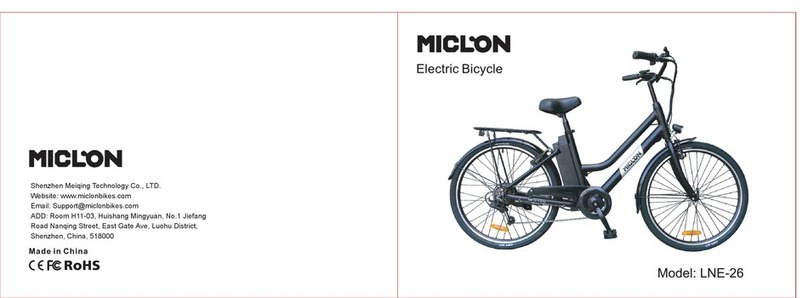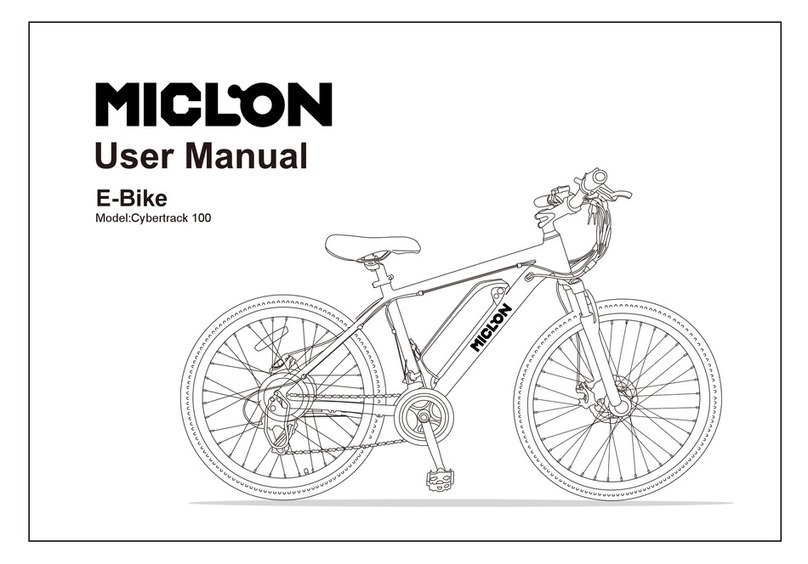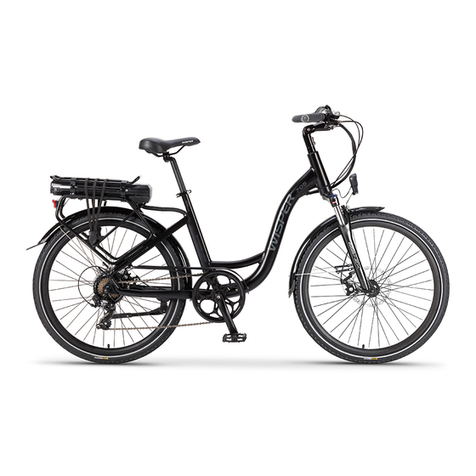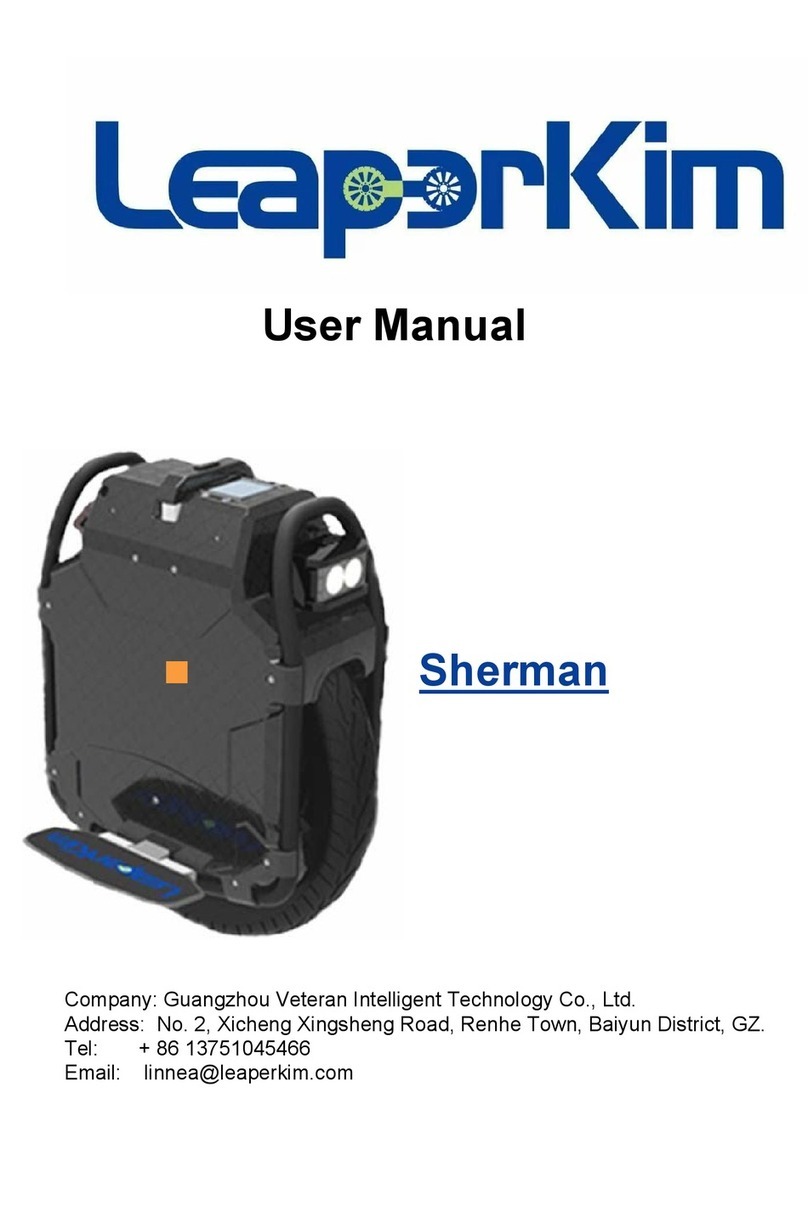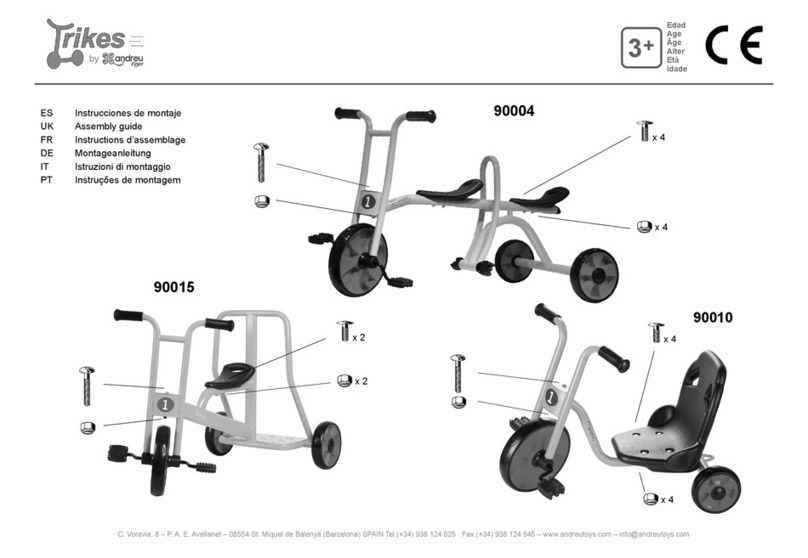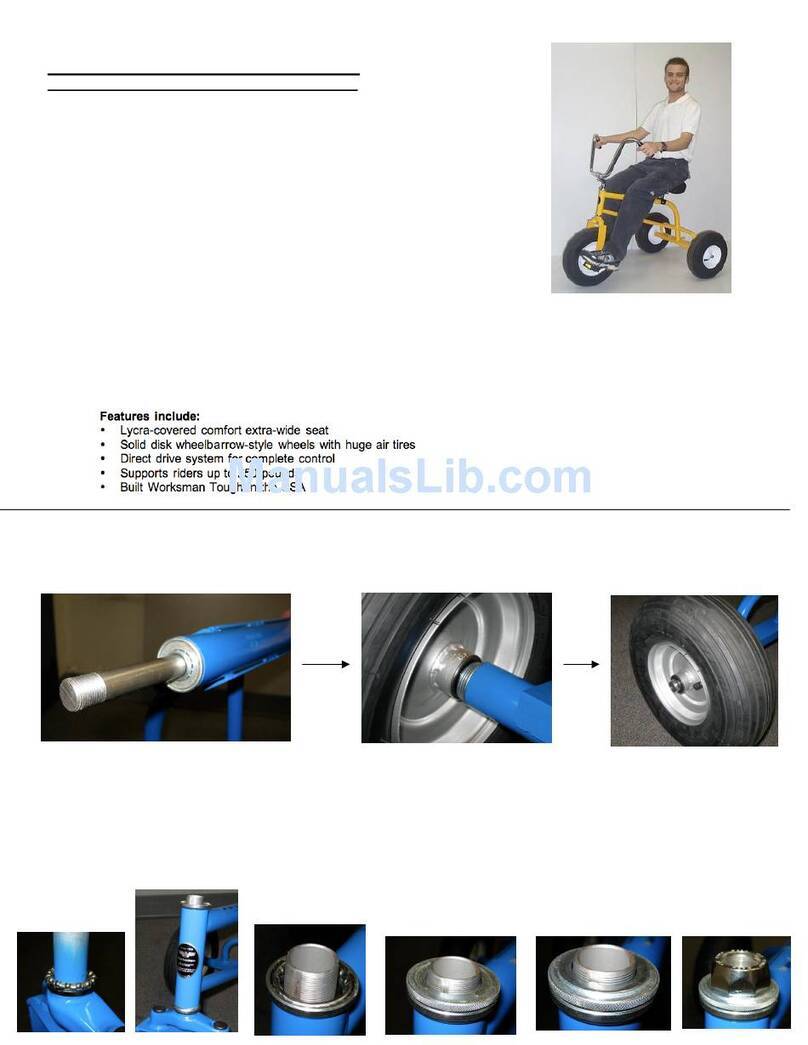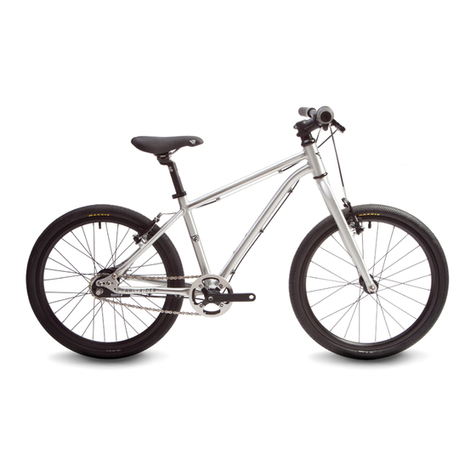MICLON Macmission 100 User manual

Electric Bike
Model:Macmission 100

Thank you for choosing MICLON.
Thank you for purchasing MICLON Macmission 100. This Manual contains both procedural and conceptual information to guide you through proper
installation, optimization, riding, and maintenance. For your safety, please read and understand every instruction in the manual before using it.
Email: [email protected]
Hotline:516-927-8658 Mon-Fri 9AM-5PM(PT)
* If your purchase was fulfilled by Amazon, please use Amazon’s 30-day return service.
- 01 -

Contents
1.PRODUCT OVERVIEW ...............................................................................................................................................
2.PACKAGE CONTENTS ...............................................................................................................................................
3.HOW TO INSTALL .......................................................................................................................................................
4.HOW TO CHARGE THE BATTERY ............................................................................................................................
5.RIDING MODE ............................................................................................................................................................
6.DISPLAY AND BUTTONS ...........................................................................................................................................
7.FOR YOUR SAFETY ...................................................................................................................................................
8.BATTERY MAINTENANCE .........................................................................................................................................
9.CLEANING ..................................................................................................................................................................
10.STORAGE .................................................................................................................................................................
11.DISPOSAL AT END-OF-LIFE .....................................................................................................................................
12.SPECIFICATIONS .....................................................................................................................................................
13.WARRANTY ..............................................................................................................................................................
- 02 -
03
04
05
12
14
15
16
17
18
19
19
20
21

1. PRODUCT OVERVIEW
E-Bike display
Gear lever
Brake
Handle
On/Off switch
Battery
Saddle
Motor
Pedal
Charging
port
Front fork
Disc brake
Quick-release
Rear derailleur
protector
- 03 -

2. PACKAGE CONTENTS
1× Bike frame + rear wheel 1× Wheel 1× Saddle
L R
2× Pedal
3× Hex key 2×Wrench
6× Screw M5*8.5
1× Screwdriver
1× Disc brake 1× Charger
1× Battery key1× Battery
2× Reflector
1× Greeting card 1× User manual
1× Quick release
Carefully check package contents, if anything is missing or damaged, please contact online customer service for support.
- 04 -

3. HOW TO INSTALL
Before Installation
Step 1 Adjust the stem
180°
Please read this user manual thoroughly and completely, and comply with the instructions it contains.
Please make sure all parts are intact and in good condition.
DO NOT install the battery or start the meter before the bike is completely installed.
If you have any questions or can not find the information you need in the user manual, please contact us at [email protected]
Turn the stem of the handlebar 180 degrees to let it face forward.
Fasten the 2 bolts on the stem with the Allen key to secure the handlebar in position.
- 05 -

Step 2 Install the handlebar
Step 3 Install the disc brake onto the front wheel
Unscrew the 4 bolts from the stem cover with the Allen key.
Rotate the handlebar and make it perpendicular to the bike frame.
Hold the stem cover tightly against the handlebar and install the 4 bolts back to the stem.
Align the disc brake with the front wheel via their hole position.
Insert and tighten 6 bolts of M5*8.5 to fix the disc brake onto the front wheel.
90°
Loosen
screws
13
2
4
- 06 -

Step 4 Install the front wheel
Warnings:
Take out the front wheel and the quick release.
Open the lever and unscrew the nut from the quick release.
Insert the quick release skewer into the wheel and make sure the small end of the two cone spring faces inward.
Keep the lever open and fasten the nut a little bit leaving enough room for the front fork dropouts.
Lower the front fork onto the front wheel. Ensure that the brake caliper clamps the brake disc and the axle goes through the front fork dropouts.
Hold the quick release lever in line with the axle and tighten the thumb nut until the lever can stay in parallel to the floor without being held. Use the
palm of your hand to close the lever fully without touching the brake rotor.
Quick-release thumb nut should be at the other side of the disc brake.
Ensure both sides of the axle are fully engaged into the front fork dropouts.
The quick-release lever secures the front wheel to the bike so the thumb nut must be tight enough so the closed lever has adequate clamping force
and keeps the axle and wheel firmly in place.
2X Spring
Each side
of the wheel
has one
cone
spring only disc brake
goes into the
brake caliper
brake caliper
- 07 -

Step 5. Install pedals
Identify the correct side by finding the marked ‘R’ and ‘L’ at the pedals.
Tighten the pedal with hands at first. Tighten the right pedal clockwise and tighten the left counterclockwise.
Completely tighten the pedals with a pedal wrench or an open-end wrench.
When installing,
L to L, R to R
LR
- 08 -

Step 6. Install the saddle
Open the clamp under the seat. Pull the seat up or push it down to adjust the height.
Close the clamp to secure the seat in place. Do not raise the saddle higher than the safety line.
10
9
8
7
6
5
4
3
2
1
Safety Line
- 09 -

Step 7. Install the battery
Step 8. Install the front reflector
Insert the battery into the middle frame and lock it with the battery key.
Insert the battery key and turn it to the unlock position before pulling the battery out.
Ensure the battery switch is on for boosting your ride.
Take out the white reflector and 1× screw of M5*10.
Install the reflector on the handlebars.
Tighten the screws with the screwdriver and complete front reflector installation.
OFF/ON
- 10 -

Step 9. Install rear reflector
Take out the red reflector and 1× screw of M5*10.
Install the reflector on the saddle tube.
Tighten the screws with the screwdriver and complete rear reflector installation.
- 11 -

4. HOW TO CHARGE THE BATTERY
Charging instructions
Charge the E-Bike before the first ride. It takes about 3 hours to fully charge the battery.
Step 1. Make sure the bike is turned off and check the connection of the charging cable and power adapter.
Step 2. Plug the charger into a wall outlet (100V-240V) then plug the other end into the charging port of the E-Bike. Rotate the switch cap as needed.
Step 3. The power adapter’s light will turn green from red after about 3-hour charging. Disconnect all cables once charging is completed.
For your convenience, the battery can also be charged while detached from the MICLON Macmission 100 E-Bike.
Slide-Out Charging
Port Design
- 12 -

Detach and attach
For users' convenience, the MICLON Macmission 100 E-Bike's battery is both removable and lockable to the frame as demanded.
Battery detachment: Insert the battery key and turn it to the unlock position for detaching the battery from the bike frame.
Battery attachment: Insert the battery into the frame. Turn the battery key to the locking position.
Battery safety
The battery is designed with a non-discharge feature during its charging process, which results in no response when the bike is charging. The meter
therefore cannot be used during the charging. Check the battery level by observing the charger's indicator or by pressing the button on the battery
compartment.
Fully charge the battery before your first use. It takes about 3 hours.
Perform periodic visual inspections on the battery ports and charging cables.
Keep your charging environment clean and dry at all times.
DO NOT charge your E-Bike if the charging port is damp or has any liquid on it.
Avoid charging your E-Bike in extremely hot or cold environments to capitalize on the maximum efficiency of the battery.
DO NOT use the bike while it is charging or connected to the charger under any circumstances.
The charging time is 3 hours approx. Long-time charging may deduct battery life and performance.
Use the charger provided with your Macmission 100 E-Bike only. If the official charger is lost or damaged, please contact customer support to obtain
a replacement.
Always lock the battery with the enclosed battery key and pull out the key before riding the E-Bike.
- 13 -

5. RIDING MODES
0
1-5
Display OFF
×
× ×
Pure Electric BikeSpeed Modes Assisted Bike
Gear button ThrottleGear lever
Electric bike display
Handlebar
Pure E-Bike - Turn on LCD smart display and switch the speed
modes from 1~5 by rotating the throttle.
Pedal-assist Bike - Turn on LCD smart display and switch the
speed modes from 1~5 by pedaling.
Normal Bike - Turn off the LCD smart display and pedal like a
normal bike.
- 14 -

6. DISPLAY AND BUTTONS
Display information
Battery level: This icon indicates the battery remainder.
Speed display: This icon indicates the current speed in mph.
Motor power: This icon indicates the current motor power.
Speed mode: This icon indicates the current speed level.
Button information
: Quick-press to switch from speed modes 5 to 1.
: Press and hold for ~2 seconds to turn the E-Bike on/off.
: Quick-press to switch from speed modes 1 to 5.
WARNING:
in the speed mode area of the display.
- 15 -
SPEED TRIP ODO
Battery level
Speed display OFF/ON
Subtraction
Addition

Check whether the quick-release screws and saddle are secure and whether the brakes are effective.
Inspect the saddle, gears, and tire pressure. Proper tire inflation can reduce flats and improve performance, including travel distance per charge.
Check the handlebars and screws once a week at least.
Doing the above routine inspections before and after every ride will help you maintain optimal bike performance and spot potential problems before
they turn into safety concerns.
Bikes require regular maintenance. Take your bike into your local bike shop for a tune-up twice a year. Crucial components should always be inspected,
serviced, and adjusted by experienced mechanics.
Wear a qualified helmet and other protective equipment to reduce any possible injuries.
Helmets can reduce 85% of critical head injuries.
Elbow pads can reduce 82% of elbow injuries.
Knee pads can reduce 32% of knee injuries.
In order to avoid accidental movement during waiting for a green light, please adjust the speed mode down to zero, or squeeze the brake.
Make sure your feet are always on the pedals and both hands are on the bike handle when riding. Taking your feet off the pedals during riding is
dangerous.
7. FOR YOUR SAFETY
Read the following information thoroughly and carefully for having a safe riding experience. Before riding, always check to make sure your brakes can
work properly.
Before your first ride
Semi-Annual bike mechanic inspections
ATTENTION:
NOTE:
- 16 -
Check whether the quick-release screws and saddle are secure and whether the brakes are effective.
Inspect the saddle, gears, and tire pressure. Proper tire inflation can reduce flats and improve performance, including travel distance per charge.
Check the handlebars and screws once a week at least.
Doing the above routine inspections before and after every ride will help you maintain optimal bike performance and spot potential problems before
they turn into safety concerns.
Bikes require regular maintenance. Take your bike into your local bike shop for a tune-up twice a year. Crucial components should always be inspected,
serviced, and adjusted by experienced mechanics.
Wear a qualified helmet and other protective equipment to reduce any possible injuries.
Helmets can reduce 85% of critical head injuries.
Elbow pads can reduce 82% of elbow injuries.
Knee pads can reduce 32% of knee injuries.
In order to avoid accidental movement during waiting for a green light, please adjust the speed mode down to zero, or squeeze the brake.
Make sure your feet are always on the pedals and both hands are on the bike handle when riding. Taking your feet off the pedals during riding is
dangerous.
Read the following information thoroughly and carefully for having a safe riding experience. Before riding, always check to make sure your brakes can
work properly.
Before your first ride
Semi-Annual bike mechanic inspections
ATTENTION:
NOTE:
Check whether the quick-release screws and saddle are secure and whether the brakes are effective.
Inspect the saddle, gears, and tire pressure. Proper tire inflation can reduce flats and improve performance, including travel distance per charge.
Check the handlebars and screws once a week at least.
Doing the above routine inspections before and after every ride will help you maintain optimal bike performance and spot potential problems before
they turn into safety concerns.
Bikes require regular maintenance. Take your bike into your local bike shop for a tune-up twice a year. Crucial components should always be inspected,
serviced, and adjusted by experienced mechanics.
Wear a qualified helmet and other protective equipment to reduce any possible injuries.
Helmets can reduce 85% of critical head injuries.
Elbow pads can reduce 82% of elbow injuries.
Knee pads can reduce 32% of knee injuries.
In order to avoid accidental movement during waiting for a green light, please adjust the speed mode down to zero, or squeeze the brake.
Make sure your feet are always on the pedals and both hands are on the bike handle when riding. Taking your feet off the pedals during riding is
dangerous.
Read the following information thoroughly and carefully for having a safe riding experience. Before riding, always check to make sure your brakes can
work properly.
Before your first ride
Semi-Annual bike mechanic inspections
ATTENTION:
NOTE:
Check whether the quick-release screws and saddle are secure and whether the brakes are effective.
Inspect the saddle, gears, and tire pressure. Proper tire inflation can reduce flats and improve performance, including travel distance per charge.
Check the handlebars and screws once a week at least.
Doing the above routine inspections before and after every ride will help you maintain optimal bike performance and spot potential problems before
they turn into safety concerns.
Bikes require regular maintenance. Take your bike into your local bike shop for a tune-up twice a year. Crucial components should always be inspected,
serviced, and adjusted by experienced mechanics.
Wear a qualified helmet and other protective equipment to reduce any possible injuries.
Helmets can reduce 85% of critical head injuries.
Elbow pads can reduce 82% of elbow injuries.
Knee pads can reduce 32% of knee injuries.
In order to avoid accidental movement during waiting for a green light, please adjust the speed mode down to zero, or squeeze the brake.
Make sure your feet are always on the pedals and both hands are on the bike handle when riding. Taking your feet off the pedals during riding is
dangerous.
Read the following information thoroughly and carefully for having a safe riding experience. Before riding, always check to make sure your brakes can
work properly.
Before your first ride
Semi-Annual bike mechanic inspections
ATTENTION:
NOTE:

A well-maintained battery can perform well even after riding for high mileage. Recharge the battery after each ride to prevent the battery from completely
draining. When used at room temperature (70°F [22°C]), the battery performance is at its best. However, using it at temperatures below 32°F (0°C) will
reduce the performance. Generally, at -4°F (-20°C) battery performance declines as low as half of the same battery at 70°F (22°C). When the temperature
rises, the battery life will be restored.
Refer to local laws and regulations on battery recycling and/or disposal.
NOTE:
DO NOT use the E-Bike to perform dangerous maneuvers. Failure to exercise good judgment and heed the above warnings increases the risk of
serious injury or, in very rare cases, death.
Make sure the battery is fully charged, especially for long travels.
For your safety and the safety of others, follow the speed limit and ride only at the speed you are comfortable with, and be ready to stop at any time.
Keep a safe distance from other riders to avoid collisions.
Pay attention to your surroundings avoiding obstacles and unsafe surfaces.
Ride in open spaces and flat areas. Avoid slopes or high traffic areas if possible.
DO NOT ride at high speeds, on uneven terrain, in inclement weather, or otherwise unsafe conditions.
Never use the E-Bike to do anything that may cause personal injury or property damage.
DO NOT attempt to carry passengers or heavy items. The bike can only support the weight of one person at a time. Do not exceed the weight limit.
Ride the E-Bike in the allowable area only. You MUST follow local laws and yield to pedestrians.
Generally, a fully charged battery can maintain power for 90 days in standby mode. Remember to charge the battery after each use. Draining the
battery may cause permanent damage to the battery. The electronics inside of the battery record the charge and discharge of the battery. Damages
caused by over-discharge or under-discharge are not covered by the warranty duty.
A well-maintained battery can perform well even after riding for high mileage. Recharge the battery after each ride to prevent the battery from completely
draining. When used at room temperature (70°F [22°C]), the battery performance is at its best. However, using it at temperatures below 32°F (0°C) will
reduce the performance. Generally, at -4°F (-20°C) battery performance declines as low as half of the same battery at 70°F (22°C). When the temperature
rises, the battery life will be restored.
Refer to local laws and regulations on battery recycling and/or disposal.
NOTE:
DO NOT use the E-Bike to perform dangerous maneuvers. Failure to exercise good judgment and heed the above warnings increases the risk of
serious injury or, in very rare cases, death.
Make sure the battery is fully charged, especially for long travels.
For your safety and the safety of others, follow the speed limit and ride only at the speed you are comfortable with, and be ready to stop at any time.
Keep a safe distance from other riders to avoid collisions.
Pay attention to your surroundings avoiding obstacles and unsafe surfaces.
Ride in open spaces and flat areas. Avoid slopes or high traffic areas if possible.
DO NOT ride at high speeds, on uneven terrain, in inclement weather, or otherwise unsafe conditions.
Never use the E-Bike to do anything that may cause personal injury or property damage.
DO NOT attempt to carry passengers or heavy items. The bike can only support the weight of one person at a time. Do not exceed the weight limit.
Ride the E-Bike in the allowable area only. You MUST follow local laws and yield to pedestrians.
Generally, a fully charged battery can maintain power for 90 days in standby mode. Remember to charge the battery after each use. Draining the
battery may cause permanent damage to the battery. The electronics inside of the battery record the charge and discharge of the battery. Damages
caused by over-discharge or under-discharge are not covered by the warranty duty.
8. BATTERY MAINTENANCE
- 17 -
A well-maintained battery can perform well even after riding for high mileage. Recharge the battery after each ride to prevent the battery from completely
draining. When used at room temperature (70°F [22°C]), the battery performance is at its best. However, using it at temperatures below 32°F (0°C) will
reduce the performance. Generally, at -4°F (-20°C) battery performance declines as low as half of the same battery at 70°F (22°C). When the temperature
rises, the battery life will be restored.
Refer to local laws and regulations on battery recycling and/or disposal.
NOTE:
DO NOT use the E-Bike to perform dangerous maneuvers. Failure to exercise good judgment and heed the above warnings increases the risk of
serious injury or, in very rare cases, death.
Make sure the battery is fully charged, especially for long travels.
For your safety and the safety of others, follow the speed limit and ride only at the speed you are comfortable with, and be ready to stop at any time.
Keep a safe distance from other riders to avoid collisions.
Pay attention to your surroundings avoiding obstacles and unsafe surfaces.
Ride in open spaces and flat areas. Avoid slopes or high traffic areas if possible.
DO NOT ride at high speeds, on uneven terrain, in inclement weather, or otherwise unsafe conditions.
Never use the E-Bike to do anything that may cause personal injury or property damage.
DO NOT attempt to carry passengers or heavy items. The bike can only support the weight of one person at a time. Do not exceed the weight limit.
Ride the E-Bike in the allowable area only. You MUST follow local laws and yield to pedestrians.
Generally, a fully charged battery can maintain power for 90 days in standby mode. Remember to charge the battery after each use. Draining the
battery may cause permanent damage to the battery. The electronics inside of the battery record the charge and discharge of the battery. Damages
caused by over-discharge or under-discharge are not covered by the warranty duty.
Doing the above routine inspections before and after every ride will help you maintain optimal bike performance and spot potential problems before
Bikes require regular maintenance. Take your bike into your local bike shop for a tune-up twice a year. Crucial components should always be inspected,
Make sure your feet are always on the pedals and both hands are on the bike handle when riding. Taking your feet off the pedals during riding is
Read the following information thoroughly and carefully for having a safe riding experience. Before riding, always check to make sure your brakes can
A well-maintained battery can perform well even after riding for high mileage. Recharge the battery after each ride to prevent the battery from completely
draining. When used at room temperature (70°F [22°C]), the battery performance is at its best. However, using it at temperatures below 32°F (0°C) will
reduce the performance. Generally, at -4°F (-20°C) battery performance declines as low as half of the same battery at 70°F (22°C). When the temperature
rises, the battery life will be restored.
Refer to local laws and regulations on battery recycling and/or disposal.
NOTE:
DO NOT use the E-Bike to perform dangerous maneuvers. Failure to exercise good judgment and heed the above warnings increases the risk of
serious injury or, in very rare cases, death.
Make sure the battery is fully charged, especially for long travels.
For your safety and the safety of others, follow the speed limit and ride only at the speed you are comfortable with, and be ready to stop at any time.
Keep a safe distance from other riders to avoid collisions.
Pay attention to your surroundings avoiding obstacles and unsafe surfaces.
Ride in open spaces and flat areas. Avoid slopes or high traffic areas if possible.
DO NOT ride at high speeds, on uneven terrain, in inclement weather, or otherwise unsafe conditions.
Never use the E-Bike to do anything that may cause personal injury or property damage.
DO NOT attempt to carry passengers or heavy items. The bike can only support the weight of one person at a time. Do not exceed the weight limit.
Ride the E-Bike in the allowable area only. You MUST follow local laws and yield to pedestrians.
Generally, a fully charged battery can maintain power for 90 days in standby mode. Remember to charge the battery after each use. Draining the
battery may cause permanent damage to the battery. The electronics inside of the battery record the charge and discharge of the battery. Damages
caused by over-discharge or under-discharge are not covered by the warranty duty.
Inspect the saddle, gears, and tire pressure. Proper tire inflation can reduce flats and improve performance, including travel distance per charge.
Doing the above routine inspections before and after every ride will help you maintain optimal bike performance and spot potential problems before
Bikes require regular maintenance. Take your bike into your local bike shop for a tune-up twice a year. Crucial components should always be inspected,
Make sure your feet are always on the pedals and both hands are on the bike handle when riding. Taking your feet off the pedals during riding is
Read the following information thoroughly and carefully for having a safe riding experience. Before riding, always check to make sure your brakes can

Fully charge the E-Bike before storing to prevent the battery from over-discharge due to long-term storage.
If the E-Bike needs to be stored for more than one month, discharge and recharge the battery at least once a month.
NOTE:
DO NOT store the E-Bike outdoors for too long. Exposure to sunlight and extreme temperatures (whether hot or cold) will accelerate the aging process
of plastic parts and may reduce battery life.
Store the E-Bike in a cool and dry place.
DO NOT store in a dusty environment as this may cause damage over time. Cover the E-Bike to keep dust out.
This product MUST NOT be disposed of by incineration, landfilling, or mixing with household trash. Improper disposal of the battery contained within
this product may result in the battery heating up, rupturing, or igniting which may cause serious injury.
The substances contained inside the battery present chemical risks to the environment. The recommended disposal for any MICLON product at its
end-of-life is to dispose of the entire unit at or through an e-waste recycling center, program, or facility.
Local regulations and laws about the recycling and disposal of lithium-ion batteries and/or products containing them will vary according to country,
state, and local governments. You must check laws and regulations corresponding to where you live to properly dispose of the battery and/or unit.
It is the user’s responsibility to dispose of their waste equipment properly by local regulations and laws.
For additional information about dropping off your batteries and electrical or electronic waste, please contact your local waste-management office or
household waste disposal service.
ATTENTION:
Before cleaning, make sure that the power has been turned off and the charging cable has been unplugged. Otherwise, you may damage electronic
components. Proper cleaning of your E-Bike can guarantee a longer lifespan and a smooth-riding experience.
NOTE:
DO NOT perform any kind of maintenance while the E-Bike is powered on or charging.
DO NOT store or recharge the battery in temperature exceeds the specified range of 20°C-25°C / 68°F-77°F. Do not pierce the battery.
DO NOT attempt to disassemble the battery for fear of fire hazards.
DO NOT ride the E-Bike when the ambient temperature exceeds the machine's maximum operating temperature (see specifications), as low/high
temperature will limit the maximum power/torque. Doing so may cause personal injury or property loss.
Wipe the outer body of your E-Bike with a soft, dry microfiber cloth.
Check around the wheels and ensure there is no foreign material. The E-Bike’s design allows for easy wheel maintenance.
The E-Bike features IPX4 water resistance, which means it can withstand splashes. However, do not submerge the E-Bike in water.
DO NOT use alcohol, gasoline, acetone, or other corrosive/volatile solvents to clean the bicycle. These substances may damage the appearance and
the internal structure of your bicycle.
DO NOT let water and liquids get into the E-Bike’s electric parts or battery.
ATTENTION:
Before cleaning, make sure that the power has been turned off and the charging cable has been unplugged. Otherwise, you may damage electronic
components. Proper cleaning of your E-Bike can guarantee a longer lifespan and a smooth-riding experience.
NOTE:
DO NOT perform any kind of maintenance while the E-Bike is powered on or charging.
DO NOT store or recharge the battery in temperature exceeds the specified range of 20°C-25°C / 68°F-77°F. Do not pierce the battery.
DO NOT attempt to disassemble the battery for fear of fire hazards.
DO NOT ride the E-Bike when the ambient temperature exceeds the machine's maximum operating temperature (see specifications), as low/high
temperature will limit the maximum power/torque. Doing so may cause personal injury or property loss.
Wipe the outer body of your E-Bike with a soft, dry microfiber cloth.
Check around the wheels and ensure there is no foreign material. The E-Bike’s design allows for easy wheel maintenance.
The E-Bike features IPX4 water resistance, which means it can withstand splashes. However, do not submerge the E-Bike in water.
DO NOT use alcohol, gasoline, acetone, or other corrosive/volatile solvents to clean the bicycle. These substances may damage the appearance and
the internal structure of your bicycle.
DO NOT let water and liquids get into the E-Bike’s electric parts or battery.
ATTENTION:
Before cleaning, make sure that the power has been turned off and the charging cable has been unplugged. Otherwise, you may damage electronic
components. Proper cleaning of your E-Bike can guarantee a longer lifespan and a smooth-riding experience.
NOTE:
DO NOT perform any kind of maintenance while the E-Bike is powered on or charging.
DO NOT store or recharge the battery in temperature exceeds the specified range of 20°C-25°C / 68°F-77°F. Do not pierce the battery.
DO NOT attempt to disassemble the battery for fear of fire hazards.
DO NOT ride the E-Bike when the ambient temperature exceeds the machine's maximum operating temperature (see specifications), as low/high
temperature will limit the maximum power/torque. Doing so may cause personal injury or property loss.
Wipe the outer body of your E-Bike with a soft, dry microfiber cloth.
Check around the wheels and ensure there is no foreign material. The E-Bike’s design allows for easy wheel maintenance.
The E-Bike features IPX4 water resistance, which means it can withstand splashes. However, do not submerge the E-Bike in water.
DO NOT use alcohol, gasoline, acetone, or other corrosive/volatile solvents to clean the bicycle. These substances may damage the appearance and
the internal structure of your bicycle.
DO NOT let water and liquids get into the E-Bike’s electric parts or battery.
9. CLEANING
- 18 -
DO NOT use the E-Bike to perform dangerous maneuvers. Failure to exercise good judgment and heed the above warnings increases the risk of
Generally, a fully charged battery can maintain power for 90 days in standby mode. Remember to charge the battery after each use. Draining the
battery may cause permanent damage to the battery. The electronics inside of the battery record the charge and discharge of the battery. Damages
ATTENTION:
Before cleaning, make sure that the power has been turned off and the charging cable has been unplugged. Otherwise, you may damage electronic
components. Proper cleaning of your E-Bike can guarantee a longer lifespan and a smooth-riding experience.
NOTE:
DO NOT perform any kind of maintenance while the E-Bike is powered on or charging.
DO NOT store or recharge the battery in temperature exceeds the specified range of 20°C-25°C / 68°F-77°F. Do not pierce the battery.
DO NOT attempt to disassemble the battery for fear of fire hazards.
DO NOT ride the E-Bike when the ambient temperature exceeds the machine's maximum operating temperature (see specifications), as low/high
temperature will limit the maximum power/torque. Doing so may cause personal injury or property loss.
Wipe the outer body of your E-Bike with a soft, dry microfiber cloth.
Check around the wheels and ensure there is no foreign material. The E-Bike’s design allows for easy wheel maintenance.
The E-Bike features IPX4 water resistance, which means it can withstand splashes. However, do not submerge the E-Bike in water.
DO NOT use alcohol, gasoline, acetone, or other corrosive/volatile solvents to clean the bicycle. These substances may damage the appearance and
the internal structure of your bicycle.
DO NOT let water and liquids get into the E-Bike’s electric parts or battery.

Fully charge the E-Bike before storing to prevent the battery from over-discharge due to long-term storage.
If the E-Bike needs to be stored for more than one month, discharge and recharge the battery at least once a month.
NOTE:
DO NOT store the E-Bike outdoors for too long. Exposure to sunlight and extreme temperatures (whether hot or cold) will accelerate the aging process
of plastic parts and may reduce battery life.
Store the E-Bike in a cool and dry place.
DO NOT store in a dusty environment as this may cause damage over time. Cover the E-Bike to keep dust out.
This product MUST NOT be disposed of by incineration, landfilling, or mixing with household trash. Improper disposal of the battery contained within
this product may result in the battery heating up, rupturing, or igniting which may cause serious injury.
The substances contained inside the battery present chemical risks to the environment. The recommended disposal for any MICLON product at its
end-of-life is to dispose of the entire unit at or through an e-waste recycling center, program, or facility.
Local regulations and laws about the recycling and disposal of lithium-ion batteries and/or products containing them will vary according to country,
state, and local governments. You must check laws and regulations corresponding to where you live to properly dispose of the battery and/or unit.
It is the user’s responsibility to dispose of their waste equipment properly by local regulations and laws.
For additional information about dropping off your batteries and electrical or electronic waste, please contact your local waste-management office or
household waste disposal service.
Fully charge the E-Bike before storing to prevent the battery from over-discharge due to long-term storage.
If the E-Bike needs to be stored for more than one month, discharge and recharge the battery at least once a month.
NOTE:
DO NOT store the E-Bike outdoors for too long. Exposure to sunlight and extreme temperatures (whether hot or cold) will accelerate the aging process
of plastic parts and may reduce battery life.
Store the E-Bike in a cool and dry place.
DO NOT store in a dusty environment as this may cause damage over time. Cover the E-Bike to keep dust out.
This product MUST NOT be disposed of by incineration, landfilling, or mixing with household trash. Improper disposal of the battery contained within
this product may result in the battery heating up, rupturing, or igniting which may cause serious injury.
The substances contained inside the battery present chemical risks to the environment. The recommended disposal for any MICLON product at its
end-of-life is to dispose of the entire unit at or through an e-waste recycling center, program, or facility.
Local regulations and laws about the recycling and disposal of lithium-ion batteries and/or products containing them will vary according to country,
state, and local governments. You must check laws and regulations corresponding to where you live to properly dispose of the battery and/or unit.
It is the user’s responsibility to dispose of their waste equipment properly by local regulations and laws.
For additional information about dropping off your batteries and electrical or electronic waste, please contact your local waste-management office or
household waste disposal service.
Fully charge the E-Bike before storing to prevent the battery from over-discharge due to long-term storage.
If the E-Bike needs to be stored for more than one month, discharge and recharge the battery at least once a month.
NOTE:
DO NOT store the E-Bike outdoors for too long. Exposure to sunlight and extreme temperatures (whether hot or cold) will accelerate the aging process
of plastic parts and may reduce battery life.
Store the E-Bike in a cool and dry place.
DO NOT store in a dusty environment as this may cause damage over time. Cover the E-Bike to keep dust out.
This product MUST NOT be disposed of by incineration, landfilling, or mixing with household trash. Improper disposal of the battery contained within
this product may result in the battery heating up, rupturing, or igniting which may cause serious injury.
The substances contained inside the battery present chemical risks to the environment. The recommended disposal for any MICLON product at its
end-of-life is to dispose of the entire unit at or through an e-waste recycling center, program, or facility.
Local regulations and laws about the recycling and disposal of lithium-ion batteries and/or products containing them will vary according to country,
state, and local governments. You must check laws and regulations corresponding to where you live to properly dispose of the battery and/or unit.
It is the user’s responsibility to dispose of their waste equipment properly by local regulations and laws.
For additional information about dropping off your batteries and electrical or electronic waste, please contact your local waste-management office or
household waste disposal service.
Fully charge the E-Bike before storing to prevent the battery from over-discharge due to long-term storage.
If the E-Bike needs to be stored for more than one month, discharge and recharge the battery at least once a month.
NOTE:
DO NOT store the E-Bike outdoors for too long. Exposure to sunlight and extreme temperatures (whether hot or cold) will accelerate the aging process
of plastic parts and may reduce battery life.
Store the E-Bike in a cool and dry place.
DO NOT store in a dusty environment as this may cause damage over time. Cover the E-Bike to keep dust out.
This product MUST NOT be disposed of by incineration, landfilling, or mixing with household trash. Improper disposal of the battery contained within
this product may result in the battery heating up, rupturing, or igniting which may cause serious injury.
The substances contained inside the battery present chemical risks to the environment. The recommended disposal for any MICLON product at its
end-of-life is to dispose of the entire unit at or through an e-waste recycling center, program, or facility.
Local regulations and laws about the recycling and disposal of lithium-ion batteries and/or products containing them will vary according to country,
state, and local governments. You must check laws and regulations corresponding to where you live to properly dispose of the battery and/or unit.
It is the user’s responsibility to dispose of their waste equipment properly by local regulations and laws.
For additional information about dropping off your batteries and electrical or electronic waste, please contact your local waste-management office or
household waste disposal service.
10. STORAGE
11. DISPOSAL AT END-OF-LIFE
- 19 -
Table of contents
Other MICLON Bicycle manuals
Popular Bicycle manuals by other brands

Canyon
Canyon ROADLITE:ON R116 quick start guide
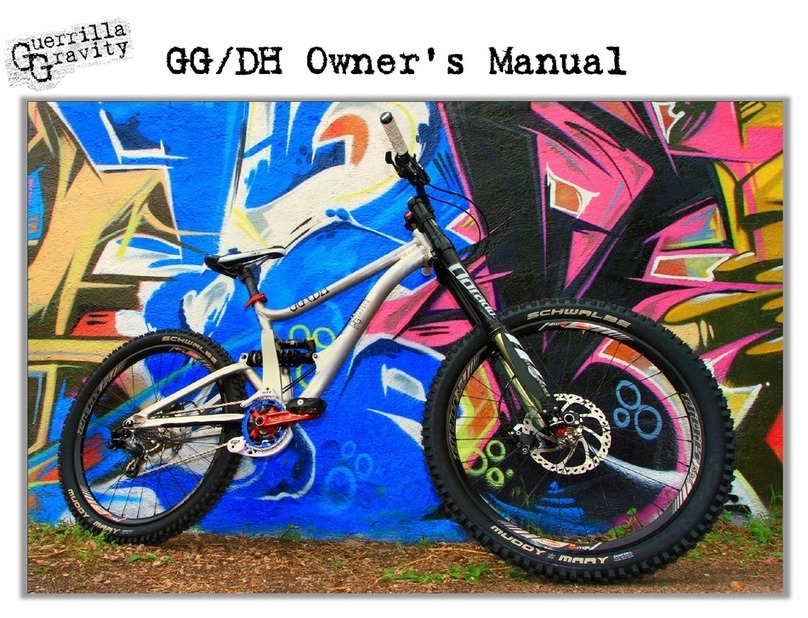
Guerrilla Gravity
Guerrilla Gravity GG/DH owner's manual

MONTAGUE
MONTAGUE DIRECT CONNECT owner's manual

MBM
MBM METIS 29 user manual

Green Bike Electric Motion
Green Bike Electric Motion City Premium 2020 instruction manual

TVS
TVS Rockz Installer's & owner's manual
